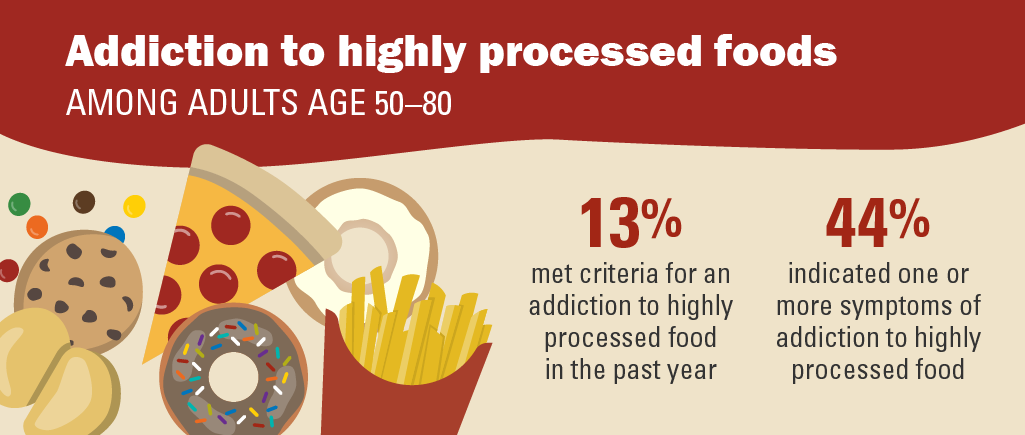
Highly processed foods like sweetened beverages, chips, and fast food can be addictive for some people, just like cigarettes and alcohol. Symptoms of addiction to highly processed food include feeling a loss of control over consumption, intense cravings, and signs of withdrawal (e.g., irritability, difficulty concentrating, or headaches). In July 2022, the University of Michigan National Poll on Healthy Aging asked a national sample of adults age 50–80 about symptoms of addiction to highly processed food and explored how these symptoms related to their physical and mental health and feelings of social isolation.
Highly processed food and symptoms of addiction
Based on their responses to items from the modified Yale Food Addiction Scale 2.0, 13% of adults age 50–80 met criteria for addiction to highly processed food in the past year (i.e., they had two or more symptoms out of 11 plus significant impairment or distress as shown in Table 1 on page 3).
Nearly half of older adults (44%) indicated at least one symptom of addiction to highly processed food. The most common symptoms were intense cravings (24% at least once a week), inability to cut down intake despite a desire to do so (19% at least 2–3 times a week), and signs of withdrawal (17% at least once a week). About one in eight adults age 50–80 (12%) reported that their eating behavior caused them a lot of distress at least 2–3 times a week, and 9% indicated their intake of highly processed foods caused significant problems in their life at least 2–3 times a week.

Comparisons by gender and health status
Women were more than twice as likely as men to meet criteria for addiction to highly processed food (18% vs. 8%), as were adults age 50–64 compared with those age 65–80 (17% vs. 8%); women age 50–64 were the most likely to meet the criteria (22%).
Meeting criteria for addiction to highly processed food was also more common among older adults who self-reported having fair or poor physical health (women 32%; men 14%) compared with those
who reported excellent, very good, or good physical health (women 15%; men 6%).
Among men who self-reported being overweight, 17% met criteria for addiction, as compared with 1% of men who reported being about the right weight. About one in three women who indicated being overweight met addiction criteria (34%), compared with 4% of women who reported being about the right weight (Table 2).
Connections to mental health
Older adults who rated their mental health as fair or poor were at least three times more likely to meet food addiction criteria compared with those reporting excellent, very good, or good mental health (women 45% vs. 15%; men 23% vs. 6%). Meeting criteria for addiction to highly processed food was also more likely for older adults who reported often feeling isolated from others (women 51%; men 26%) compared with those who rarely felt isolated (women 8%; men 4%).
Implications
Highly processed foods with unnaturally elevated levels of ingredients like sugar and fat are a substantial source of calories for many Americans, including older adults. Nutrient-poor diets dominated by these foods are a major contributor to chronic conditions such as diabetes, heart disease, and certain types of cancer, all of which are leading causes of preventable death around the world. The addictive nature of highly processed foods may contribute to how difficult it is for older adults to eat less of these products, even if they really want to eat more nutritious foods and improve their health.
One major reason highly processed foods can be addictive is because they can trigger the release of dopamine in the brain’s reward system at levels comparable to nicotine and alcohol. Many people report eating highly processed foods not only for the calories they provide, but also to experience pleasure and cope with negative emotions. Cravings for highly processed foods can also be intense and challenging to resist, and people may experience withdrawal-like symptoms when they try to reduce the amount they consume.
This poll found that more than one in ten older adults met established criteria for an addiction to highly processed food. This is similar to, or may even surpass, the prevalence of addiction to other legal and easily accessible addictive substances, such as tobacco (10%) and alcohol (4%).
Among older adults, having fair or poor physical health or mental health, being overweight, and experiencing social isolation were all associated with meeting criteria for addiction to highly processed food. The association with mental health was particularly notable for women, with nearly one out of every two women with fair or poor mental health meeting addiction criteria.
Screening for an addiction to highly processed food at health care visits (e.g., by administering the Yale Food Addiction Scale) may help to identify older adults who could benefit from additional resources such as those to address higher levels of physical and mental health care needs. Older adults identified as having an addiction to highly processed food or who express concerns about symptoms may benefit from connections to programs that offer nutrition education or provide access to healthy, affordable foods.
Data Source and Methods
This National Poll on Healthy Aging report presents findings from a nationally representative household survey conducted exclusively by NORC at the University of Chicago for the University of Michigan’s Institute for Healthcare Policy and Innovation. National Poll on Healthy Aging surveys are conducted using NORC’s AmeriSpeak probability based panel. This survey module was administered online and via phone in July 2022 to a randomly selected, stratified group of U.S. adults age 50–80 (n=2,163). The sample was subsequently weighted to reflect population figures from the U.S. Census Bureau. The completion rate was 75% among panel members contacted to participate. The margin of error is ±1 to 3 percentage points for questions asked of the full sample and higher among subgroups.
Findings from the National Poll on Healthy Aging do not represent the opinions of the University of Michigan. The University of Michigan reserves all rights over this material.
Read other National Poll on Healthy Aging reports and about the poll's Michigan findings, and learn about the poll methodology.
Citation
Gearhardt A, Singer D, Kirch M, Solway E, Roberts S, Smith E, Hutchens L, Malani P, Kullgren J. Addiction to Highly Processed Food Among Older Adults. University of Michigan National Poll on Healthy Aging. January/February 2023. Available at: https://dx.doi.org/10.7302/6792